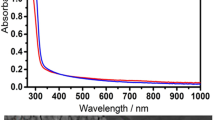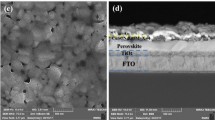Abstract
Application of a low-cost and efficient p-type inorganic hole-transporting material, copper thiocyanate (CuSCN), on mesoporous n-i-p-configurated perovskite-based devices was conducted in this study. Diethylsulfide was chosen for the preparation of precursor solution in order to deposit CuSCN layer on perovskite without degrading it. Topographical, elemental, and electrical characterizations of spin-coated CuSCN layers were performed using XRD, AFM, SEM, XPS, UPS, and UV-Vis studies. A power conversion efficiency exceeding 11.02% with an open-circuit voltage of 0.83 V was succeeded in the perovskite solar cells under full sun illumination. Low-temperature solution process used for the deposition of CuSCN and a fast solvent removal method allowed the creation of compact, highly conformal CuSCN layers that facilitate rapid carrier extraction and collection. The differences in series and recombination resistances for CuSCN-free and CuSCN-containing cells were also determined using impedance spectroscopy (IS) analysis. Moreover, the effect of TiO2 layer thickness on the cell performance was studied where these TiO2 layers were used not only for electron extraction and transportation, but also as hole blocking layer in perovskite solar cells. The impedance spectroscopy results were also consistent with the differently configurated cell performances. This work shows a well-defined n-i-p perovskite cell with optimized layers which utilize low-cost and abundant materials for photovoltaic applications.









Similar content being viewed by others
References
Nie W, Tsai H, Asadpour R, Blancon J-C, Neukirch AJ, Gupta G, Crochet JJ, Chhowalla M, Tretiak S, Alam MA, Wang HL, Mohite AD (2015) High-efficiency solution-processed perovskite solar cells with millimeter-scale grains. Science 347(6221):522–525
Ergen O, Gilbert SM, Pham T, Turner SJ, Tan MTZ, Worsley MA, Zettl A (2016) Graded bandgap perovskite solar cells. Nat Mater 16:522–525
Jeon NJ, Noh JH, Kim YC, Yang WS, Ryu S, Seok SI (2014) Solvent engineering for high-performance inorganic–organic hybrid perovskite solar cells. Nat Mater 13(9):897–903
Xiao M, Huang F, Huang W, Dkhissi Y, Zhu Y, Etheridge J, Gray-Weale A, Bach U, Cheng Y-B, Spiccia L (2014) A fast deposition-crystallization procedure for highly efficient lead iodide perovskite thin-film solar cells. Angew Chem Int Ed 53(37):9898–9903
Zuo C, Ding L (2014) An 80.11% FF record achieved for perovskite solar cells by using the NH4Cl additive. Nanoscale 6:9935
Liang P-W, Liao C-Y, Chueh C-C, Zuo F, Williams ST, Xin X-K, Lin J, Jen AK-Y (2014) Additive enhanced crystallization of solution-processed perovskite for highly efficient planar-heterojunction solar cells. Adv Mater 26(22):3748–3754
Im J-H, Jang I-H, Pellet N, Grätzel M, Park N-G (2014) Growth of CH3NH3PbI3 cuboids with controlled size for high-efficiency perovskite solar cells. Nat Nanotechnol 9(11):927–932
Yang WS, Noh JH, Jeon NJ, Kim YC, Ryu S, Seo J, Seok SI (2015) High-performance photovoltaic perovskite layers fabricated through intramolecular exchange. Science 348(6240):1234–1237
Li X, Yang J, Jiang Q, Chu W, Zhang D, Zhou Z, Ren Y, Xin J (2017) Enhanced photovoltaic performance and stability in mixed-cation perovskite solar cells via compositional modulation. Electrochim Acta 247:460–467
Zhang W, Pathak S, Sakai N, Stergiopoulos T, Nayak PK, Noel NK, Haghighirad AA, Burlakov VM, deQuilettes DW, Sadhanala A, Li W, Wang L, Ginger DS, Friend RH, Snaith HJ (2015) Enhanced optoelectronic quality of perovskite thin films with hypophosphorous acid for planar heterojunction solar cells. Nat Commun 6:10030
Liu W, Ma Z, Wang S, Jiang J, Yuan N, Ding J (2018) Low-temperature bromide modification of SnO2 for highly efficient perovskite solar cells. J Solid State Electrochem 22:3751
Bella F, Renzi P, Cavallo C, Gerbaldi C (2018) Caesium for perovskite solar cells: an overview. Chem Eur J 24:12183–12205
Pydzińska-Białek K, Szeremeta J, Wojciechowski K, Ziółek M (2018) Insights into the femtosecond to nanosecond charge carrier kinetics in perovskite materials for solar cells. J Phys Chem C 123:110–119
Abate A, Correa-Baena J-P, Saliba M, Su’ait MS, Bella F (2017) Perovskite solar cells: from the laboratory to the assembly line. Chem Eur J 24:3083–3100
Bae S, Lee SY, Kim J, Umh HN, Jeong J, Bae S, Yi J, Kim Y, Choi J (2019) Hazard potential of perovskite solar cell technology for potential implementation of “safe-by-design” approach. Sci Rep 9:4242
Ananthajothi P, Venkatachalam P (2016) Tin chloride perovskite-sensitized core/shell photoanode solar cell with spiro-MeOTAD hole transport material for enhanced solar light harvesting. J Solid State Electrochem 20:2633
Huan TN, Corte DA, Lamaison S, Karapinar D, Lutz L, Menguy N, Foldyna M, Turren-Cruz SH, Hagfeldt A, Bella F, Fontecave M, Mougel V (2019) Low-cost high-efficiency system for solar-driven conversion of CO2 to hydrocarbons. Proc Natl Acad Sci 116:9735–9740
Hu Q, Wu J, Jiang C, Liu T, Que X, Zhu R, Gonq Q (2014) Engineering of electron-selective contact for perovskite solar cells with efficiency exceeding 15%. ACS Nano 8(10):10161–10167
Wang B, Zhang Z-G, Ye S, Gao L, Yan T, Bian Z, Huang C, Li Y (2016) Solution-processable cathode buffer layer for high-performance ITO/CuSCN-based planar heterojunction perovskite solar cell. Electrochim Acta 218:263–270
Subbiah AS, Halder A, Ghosh S, Mahuli N, Hodes G, Sarkar SK (2014) Inorganic hole conducting layers for perovskite-based solar cells. J Phys Chem Lett 5:1748–1753
Heo JH, Im SH, Noh JH, Mandal TN, Lim C-S, Chang JA, Lee YH, Kim H-J, Sarkar A, Nazeeruddin MK, Grätzel M, Seok SI (2013) Efficient inorganic–organic hybrid heterojunction solar cells containing perovskite compound and polymeric hole conductors. Nat Photonics 7:486–491
Liu S, Liu R, Chen Y, Ho S, Kim JH, So F (2014) Nickel oxide hole injection/transport layers for efficient solution-processed organic light-emitting diodes. Chem Mater 26:4528–4534
Ryu MS, Jang J (2011) Enhanced efficiency of organic photovoltaic cells using solution-processed metal oxide as an anode buffer layer. Sol Energy Mater Sol Cells 95:3015–3020
Chen W, Wu Y, Yue Y, Liu J, Zhang W, Yang X, Chen H, Bi E, Ashraful I, Grätzel M, Han L (2015) Efficient and stable large-area perovskite solar cells with inorganic charge extraction layers. Science 350(6263):944–948
Christians JA, Fung RCM, Kamat PV (2014) An inorganic hole conductor for organo-lead halide perovskite solar cells improved hole conductivity with copper iodide. J Am Chem Soc 136(2):758–764
Chung I, Lee B, He J, Chang RPH, Kanatzidis MG (2012) All-solid-state dye-sensitized solar cells with high efficiency. Nature 485(7399):486–489
Qin P, Tanaka S, Ito S, Tetreault N, Manabe K, Nishino H, Nazeeruddin MK, Grätzel M (2014) Inorganic hole conductor-based lead halide perovskite solar cells with 12.4% conversion efficiency. Nat Commun 5:3834
Jaffe JE, Kaspar TJ, Droubay TC, Varga T, Bowden ME, Exarhos GJ (2010) Electronic and defect structures of CuSCN. J Phys Chem C 114:9111–9117
Ye S, Sun W, Li Y, Yan W, Peng H, Bian Z, Liu Z, Huang C (2015) CuSCN-based inverted planar perovskite solar cell with an average PCE of 15.6%. Nano Lett 15(6):3723–3728
Jung JW, Chueh CC, Jen AKY (2015) A low-temperature, solution-processable, Cu-doped nickel oxide hole-transporting layer via the combustion method for high-performance thin-film perovskite solar cells. Adv Energy Mater 5:7874–7880
Jung M, Kim YC, Jeon NJ, Yang WS, Seo J, Noh JH, Il Seok S (2016) Thermal stability of CuSCN hole conductor-based perovskite solar cells. ChemSusChem 9(18):2592–2596
Liu J, Pathak SK, Sabai N, Sheng R, Bai S, Wang Z, Snaith HJ (2016) Identification and mitigation of a critical interfacial instability in perovskite solar cells employing copper thiocyanate hole-transporter. Adv Mater Interfaces 3:1600571
Ye S, Rao H, Yan W, Li Y, Sun W, Peng H, Liu Z, Bian Z, Li Y, Huang C (2016) A strategy to simplify the preparation process of perovskite solar cells by co-deposition of a hole-conductor and a perovskite layer. Adv Mater 28(43):9648–9654
Madhavan VE, Zimmermann I, Roldan-Carmona C, Grancini G, Buffiere M, Belaidi A, Nazeeruddin MK (2016) Copper thiocyanate inorganic hole-transporting material for high-efficiency perovskite solar cells. ACS Energy Lett 1:1112–1117
Yaacobi-Gross N, Treat ND, Pattanasattayavong P, Faber H, Perumal AK, Stingelin N, Bradley DDC, Stavrinou PN, Heeney M, Anthopoulos TD (2015) High-efficiency organic photovoltaic cells based on the solution-processable hole transporting interlayer copper thiocyanate (CuSCN) as a replacement for PEDOT:PSS. Adv Energy Mater 5:1401529
Arora N, Dar MI, Hinderhofer A, Pellet N, Schreiber F, Zakeeruddin SM, Grätzel M (2017) Perovskite solar cells with CuSCN hole extraction layers yield stabilized efficiencies greater than 20%. Science 358(6364):768–771
Kim HS, Park N-G (2014) Parameters affecting I−V hysteresis of CH3NH3PbI3 perovskite solar cells: effects of perovskite crystal size and mesoporous TiO2 layer. J Phys Chem Lett 5:2927–2934
Lee JW, Kim HS, Park N-G (2016) Lewis acid−base adduct approach for high efficiency perovskite solar cells. Acc Chem Res 49(2):311–319
Cahen D, Kahn A (2003) Electron energetics at surfaces and interfaces: concepts and experiments. Adv Mater 15:271–277
Laban WA, Etgar L (2013) Depleted hole conductor-free lead halide iodide heterojunction solar cells. Energy Environ Sci 6:3249
Shi J, Dong J, Lv S, Xu Y, Zhu L, Xiao J, Xu X, Wu H, Li D, Luo Y, Meng Q (2014) Hole-conductor-free perovskite organic lead iodide heterojunction thin-film solar cells: high efficiency and junction property. Appl Phys Lett 104:063901
Tress W, Petrich A, Hummert M, Hein M, Leo K, Riede M (2011) Imbalanced mobilities causing S-shaped IV curves in planar heterojunction organic solar cells. Appl Phys Lett 98:063301
Kim H-S, Mora-Sero I, Gonzalez-Pedro V, Fabregat-Santiago F, Juarez-Perez EJ, Park N-G, Bisquert J (2013) Mechanism of carrier accumulation in perovskite thin-absorber solar cells. Nat Commun 4:2242
Liu D, Yang J, Kelly TL (2014) Compact layer free perovskite solar cells with 13.5% efficiency. J Am Chem Soc 136(49):17116–17122
Todinova A, Contreras-Bernal L, Salado M, Ahmad S, Morillo N, Idígoras J, Anta JA (2017) Towards a universal approach for the analysis of impedance spectra of perovskite solar cells: equivalent circuits and empirical analysis. ChemElectroChem 4:2891–2901
Acknowledgments
We would like to thank Ilker Yildiz from the Central Laboratory of Middle East Technical University for his assistance through XPS/UPS work. Sputtering of TiO2 blocking layer and e-beam evaporation of gold contacts were carried out at NANOTAM, Bilkent University. FE-SEM, XRD, and impedance spectroscopy measurements were carried out at the laboratories of Metallurgical and Materials Engineering Department of METU.
Funding
This work was supported by Research Fund of the Middle East Technical University, Project Number: BAP-07-02-2017-004-234.
Author information
Authors and Affiliations
Corresponding author
Additional information
Publisher’s note
Springer Nature remains neutral with regard to jurisdictional claims in published maps and institutional affiliations.
Dedicated to the memory of Ivo Alexandre Hümmelgen
Rights and permissions
About this article
Cite this article
Er, U., Icli, K.C. & Ozenbas, M. Spin-coated copper(I) thiocyanate as a hole transport layer for perovskite solar cells. J Solid State Electrochem 24, 293–304 (2020). https://doi.org/10.1007/s10008-019-04430-2
Received:
Revised:
Accepted:
Published:
Issue Date:
DOI: https://doi.org/10.1007/s10008-019-04430-2




